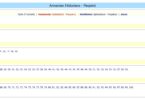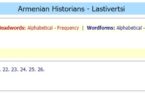Reflections on Our Linguistic Situation (1982)
Recently there have been a number of calls for Armenian academics to serve the community more directly by expressing their views on contemporary Armenian issues. I am a linguist so I will begin and end with what I know best – language. But language is the most pervasive of all life’s symbolisms, and linguistics, its study, is equally encompassing; therefore, I will of necessity touch upon issues of broader significance than language, for which infringement I apologize with due deference to specialists in those disciplines. The following is offered as a measured view both of the present linguistic situation and of the possibilities opening for the future. It is neither meant to open or close discussion, but to continue it. I am neither a partisan nor a polemicist; I merely present what I, to the best of my knowledge believe at this time to be true. But the true usually pales before the appropriate, and ideas must wait for their audience. It is my hope that there are, among the miscalculations, a few such ideas in these reflections.
Language and Culture
This is addressed first and foremost to all those who did not, by some accident of birth, live in a place where Armenian happened to be spoken in the streets, stores, schools or home.
There is a growing realization that the Armenian language, as the fundamental symbolism of Armenian life and culture, must be used in some way if we as Armenians are to know ourselves as such. In response to that realization, there is, at least in some quarters, a growing, but as yet insufficiently satisfied desire to learn the Armenian language. It is that desire which is, indirectly, articulated and addressed in this essay.
Naturally, language is not a substitute for all the other aspects of culture, but neither are any of the other aspects of culture – social, religious, artistic, literary, political, musical, culinary or choreographic – individually or in combination, substitutes for the kind of national and psychological identity language provides. Language is the stuff of which they are made, or at least understood and interpreted. While it is sometimes possible to divide linguistic form from cultural content and convey that content by translation into one of the major international languages, the coherence and ease of communications among the world’s Armenian communities is for all practical purposes lost. While the rest of the world seeks to overcome linguistic barriers, Armenians, it would seem, choose to erect them.
Let the Armenians learn from others’ experience. The Roman Catholic Church, for example, may have gained immediate comprehensibility by using the local, vernacular languages for its services, but it lost universality. It is no longer possible for a Roman Catholic to enter any Roman Catholic church and find that same universal Mass being celebrated as it is in his homeland. Besides this irreversible loss in universality, there are serious doubts whether the Mass, or any other literary creations is meant to be immediately comprehensible, without study. Most of us do not pretend to understand fully a poem or play on one hearing. There is every reason to doubt that people understand the true and more sublime meaning of a religious service any the better simply because they understand all the words at any given service they happen to attend.
One of the most deeply engrained tenets of linguistic thought is that how something is said is part of what is being said and that the way something is said may in fact override the literal content of the combined words. Form and content are one and inseparable when it comes to language and things made of language.
Language in the Late-Twentieth Century
Our aim, therefore, should be no more and no less than to find a place for the Armenian language in late-twentieth century life, of which the American situation is but a limiting case. Language is, of course, a means of communication, but in our daily lives we cannot survive speaking only Armenian. Even in Armenia this is not possible today nor will it be, whatever the regime. The Armenian predicament is the rule rather than the exception. It is not a reflection on the wealth of the language or on the proficiency of its speakers; it is a fact of life in the late-twentieth century which speakers of languages, who are a hundred times more powerful and numerous, face every day. As the Japanese who cannot use their language at the United Nations or the Arabic- or Hindi-speaking engineers who had to learn English for their work and education or the Israeli who uses English better than half the day. This is neither a negation of their identity nor a belittling of their language or culture, nor should we perceive it as such in our own case. There are, as well, plenty of people who speak languages other than, and in addition to, the official language of the state in which they live. We have something to learn from them.
Uses of Language
There are other places, and more important and fundamental uses for one’s mother tongue than the transaction of business, even at the local store, or the presentation of scientific research, even in a national institution, or the discussion of contemporary political events, even over dinner in your own home. These are aspects of universal culture which all right-minded people desire to be a part of but which have no specifically national content. Nor is anything to be gained by shutting ourselves off from these realities, denying ourselves these benefits, or setting ourselves up in a fruitless and self-defeating opposition to the other cultures of our world. This is the type of negative identity that is often preached by those who try to reduce cultures to essentials. The logic behind this type of thinking is that we are who we are because we are not like them. What is forgotten is that we would be them if we were not what we are. This negative view is rooted in abstraction and anti-historicism, bred by an infatuation with novelty and originating largely in early-twentieth-century European social science and philosophy. Just as valid is the more positive and pragmatic view which does not look at the background to define the foreground, but takes the foreground on its own terms, as it is, simply because it is there. Our culture is an inheritance which is ours not because we chose it or thought it novel or fashionable or because it is different or somehow uniquely suite to us, but simply because it has been bequeathed to us by a unique line of transmission: that of our people, our forefathers, and more distant ancestors. The largest part of cultural identity is traditional, conventional and historically unique. No other individual and not other group of people could be the same as we are. It is in this fundamental and common-sense way that we are individually and collectively unique and from this we derive, among other things, our individual and collective identity and dignity. Being unique is not a contest, therefore, to be adjudicated by scholars of comparative studies. It is an inescapable reality inherent in every being and group of beings whose existence is limited by time. Culture is not a product to be marketed, priced, bought and sold. Cultural relativity and mutual respect are the hard-earned values we, and all minority peoples, have every reason to support and practice. Affectations of superiority are no more beneficial than feelings of inferiority. Rather we must learn how to participate in the universal and still be ourselves. This is at least one path all peoples – scattered or united, with states or without – re bound to consider in the near future, and language is at least one route down that path.
Uniformity and Diversity
In certain aspects of life, but not necessarily the most important, from our point of view, greater uniformity will be the rule in the coming century. But diversity is the law of nature. Never in historical memory has there been a time, nor is there the remotest possibility that there will be a time, when mankind will be so unified and uniform that there will be no subgroups and no variations in speech. The physical – not to mention psychological, social and economic – barriers to complete uniformity have proved insurmountable in the 5000-year history of multinational states. If anything, the current trend at the level of fundamental identity runs counter to mass leveling. Dialects in America did not disappear, as was predicted, with the advent of the radio and television age. On the contrary, they became more engrained as people, by the variety of speech to which they were exposed, were awakened to their stake in linguistic diversity. Linguistic differences are stubborn. Why Armenians have not been able to capitalize on this stubbornness is a matter of early-twentieth-century American social-psychology, which is worth addressing, but it is not strictly relevant to the future, more heterogeneous America, in which we are already beginning to live.
Language as Mark of Identity
It is important to remember that the Armenian language is built out of system of symbols which have been used for at least 7000 years by at least some people who became Armenians. By whatever line of transmission, the Armenian people adopted and adapted these symbols, which are now in some one hundred or more forms the most widespread language of the world – the languages of the Indo-European family. We, the Armenian people, inherited and transmitted these and other symbols for several thousand years, putting our stamp of identity on them as a yet-more-palpable symbol of our unity and identity, thereby further distinguishing ourselves from other peoples. The linguistic philosophy Wilhelm von Humboldt described the process as follows: “Since the development of man’s human nature depends upon the nature of language, the concept of the nation as a host of people constructing a language in a definite manner is directly manifest through language.” He saw “the creation of language” as “an innate necessity of humanity. It was not a mere external vehicle, designed to sustain social intercourse, but an indispensable factor of the development of human intellectual powers, culminating in the formulation of philosophical doctrine.” Language, then, is more than a code, more than grammar. It is a cultural creation and the repository of a nation’s self-expression. It is the most transportable, flexible and enduring aspect of culture. Edward Sapir, an American linguist passionately devoted to the study and preservation of the American Indian languages, wrote: “Language . . . is the most significant and colossal work that the human spirit has evolved – nothing short of a finished form of expression for all communicable experience. This form may be endlessly varied by the individual without thereby losing its distinctive contours; and it is constantly reshaping itself as is all art. Language is the most massive and inclusive art we know, a mountainous and anonymous work of unconscious generations.”
The Armenian language is just such a “colossal work” and “indispensable factor” in Armenian life. Thousands of years have come and gone, and now, we along with speakers of all other languages, are faced with life-or-death choices about the ecology of our cultures and languages. This much is certain: there will be subgroups and it is possible to be a member of more than one group. Our limited aim should be that one of those subgroups is Armenian.
Group identity is marked in many ways, through all kinds of symbols—clothes, food, gestures, hairdo—and of course, language. What ends as different languages begins as a choice of words, a twisted meaning, a style of pronunciation and a hundred minute, subconscious but psychologically real marks of group belonging. It is through language that we present ourselves to one another in everyday life, and solely through language, for instance, on the telephone or in print. This ordinary use of language in the role of self-expression is one end of a continuum at the other end of which lie the highest articulations of a people’s ideals in literature and philosophy. These two roles – simple communication and social-expression [linguists call the instrumental and phatic] are, of course, intertwined. In every social interaction, we may or may not get our idea across, but one thing we inescapably do, for better or worse, is leave an impression and thus define ourselves. Since self-definition is the issue that is most on Armenians’ minds, let us look at language from this point of view.
Restoring the Lines of Cultural Transmission
Obviously the language must be used for it to fulfill any function whatsoever, but the extent of use and the degree of linguistic proficiency required for different purposes is correspondingly different. In ordinary life, the average American-English speaker is not called upon, and usually does not, give a lecture or write an article about some specialized topic. Even many specialists will confess that this requires a special effort. These are, however, almost purely instrumental uses of language. As soon as we stop treating language as a simple instrument whose worth is measured purely by these applications, the old utilitarian arguments for the present wholly understandable, but nonetheless deplorable apathy toward our language dissipate.
The natural lines of cultural and linguistic transmission were severed, or a least disrupted, several generations ago. We do not often consider how much is passed along these humble ties between generations. As we have found in American society at large, no system of institutions or any amount of schooling is really a substitute or the learning that used to and will again go on in the home. There was a time when the conventional wisdom was to leave child-rearing up to the schools, so much so, that the schools are now burdened with tasks they cannot possibly perform. In part the fault lies with parents for passing their responsibility onto educators, and in part with educators for discrediting parents. Under ordinary circumstances, schooling is at best a spur to learning and self-education, in our case, it is necessary to re-sow the seeds of ordinary culture so that a new generation of parents will be ready to pass along their inheritance to their children. It is an awesome task, but not unprecedented. This is a period of reinvestment. As soon as the regular lines of transmission are restored, they will, at no cost to the taxpayer or community, once again carry their share of the heavy burden of acculturation, for which they were fitted by nature and society. From all indications, the information revolution will once again make the home the center of living, learning and working. Families with better education and easier access to information, will assume more of the responsibility for teaching their children.
Putting the Armenian Language Back to Work
One of the reasons the students of this generation find learning and using Armenian frustrating is that they are better educated and have higher expectations of themselves when they learn a language. Educated speakers, whatever their native language, cannot long be satisfied with levels of self-expression incommensurate with their self-image. The easiest way to escape embarrassment is to avoid speaking the language altogether. Moreover, a fluent speaker of one language is impatient with the low and steady progress, which is the route of adult language acquisition. These, as we have seen, are obstacles which could be overcome by the next generation, if the necessary investment were made now to restore the lines of cultural transmission in the home. The easiest cure – and relatively inexpensive in comparison with found and funding institutions—is to make educational materials widely available for self-instruction in language and culture. Such materials with the proper support on hand within the community, would give the learner flexibility and convenience at a reasonable cost to both the community and the learner. Given the nature of language learning, the diversity of the community, the new technology becoming available for learning, and the hardships posed by time, distance and expense, such materials might prove better suited and more effective than traditional classes.
Learning a language is not a process that has a definite end. Even for the native speaker, language learning goes on long before and after schooling. One of the misconceptions on the part of those learning languages is that attending and passing courses is tantamount to mastery of the discipline. [This has come to be believed, equally wrongly, of many other disciplines as well. Such mastery is not something which can be taught; it must be sought and achieved by individual effort. It is not more possible to master a discipline in a term without hours of study one’s own, than a sport or musical instrument without years of solitary practice.
Language, being spontaneous and endlessly creative, demands time and perseverance. It is not the sort of skill that can be mastered in a course or two a couple of times a week. Consider how much practice we have in our native tongue. Every time we read, for instance, we not only read what we set out to read, but practice and perfect our knowledge of the language. We should expect the same when it comes to Armenian. Obviously, this is not a proposal for some diluted linguistic proficiency, but neither is it beyond reach. We all began somewhere, speaking and reading a little, before we were able to speak, read, and write a lot. Nor is this some call for high-brow culture. We often forget that the well-worn words and routines of everyday life are the immediate reality of identity. Not every American-English speaker reads poetry or even a newspaper, let alone gives lectures or is even remotely capable of writing laws or instructions or reports. An American speaker is recognized as such, merely by saying “hello,” and by creating on the spot a sample of American speech. This level of proficiency may not be satisfying for all speakers, and if the Armenian population is more ambitious all the better. But too often people have been overwhelmed by the most natural thing in the world – speaking their language. Others have done it, and we ourselves did it a few generations ago. It is not too much for Armenians to do it again today.
Attitudes and the Future
But first some of the traditional prejudices will have to be set aside. Some of the intellectual elitism will have to be eased to give people a chance. Some of the snobbishness will have to be replaced by toleration and acceptance. Some of the laziness and apathy will have to be traded for persistence and patience. Some of the reliance on institutions will have to give way to reliance on self, family and friends. Some of the self-flagellation will have to end. Some of self-appointed judges of what is or is not Armenian will have to forbear. Some of the defeatism and insularism will have to be overturned by optimism, pragmatism and open-mindedness. Some of the silent majority will have to speak up and be heard.
All of the reigning conditions are perfectly natural, unavoidable and at times even beneficial. If I judge correctly though, a different mix of these attitudes will be more advantageous in the long run.
There has never been a generation of Armenians as well educated, as prosperous or as secure as the present generation. Nothing is to be gained by berating or belittling them. They could now be in their homes creating microcosmic Armenian communities in the most convenient and durable of all social units. These are social units in which a lot more formal learning will be done in the future. One of the things which could be taught and used there is the Armenian language. This, rather than being the generation to bury the Armenian language in America, could very well be the generation to give it new life. All the old reasons for learning Armenian need not be recited nor is anything to be gained by piling guilt on anyone. Sooner or later individuals find a way to release themselves from that guilt and usually they follow the path of least resistance and simple forget it all. The all-or-nothing approach to being Armenian must, therefore, be laid to rest. Self-examination and bewailing the past have a definite place in social life, but they cannot long sustain a community nor can they be the central intellectual and social activities of a community. Every moment of time and ever drops of energy spent one way is an opportunity forgone. The real tragedies are the opportunities to be Armenian that are slipping through our hands every day.
Speaking our language is not all there is to being Armenian, but it has undeniable value, it is thus far uncontroversial, and it is a source of unexpected pleasure. Language is more pervasive than dance and song, more democratic than literature and art, more durable than architecture, more comprehensible than philosophy and political thought, more commonplace than history, more lasting than kingdoms, political movements, artistic or literary styles, more objective than fellowship and social circles; and more fundamentally a product of the people than all the other conscious, individualistic and derivative aspects of culture. Language is the most natural, spontaneous and all-encompassing form of cultural expression.
Human beings are among other things, gregarious, talking beings, and realizing their linguistic potential is a source of great satisfaction. While we are thrashing out the problems which divide us in other spheres of life, one thing we can do is return to the age-old activity of creating our language together.
These reflections were contributed by Dr. Thomas J. Samuelian, Tarzian Instructor in Armenian Language (University of Pennsylvania) and newly appointed Assistance Professor of Armenian Language at Columbia University, (1982).







